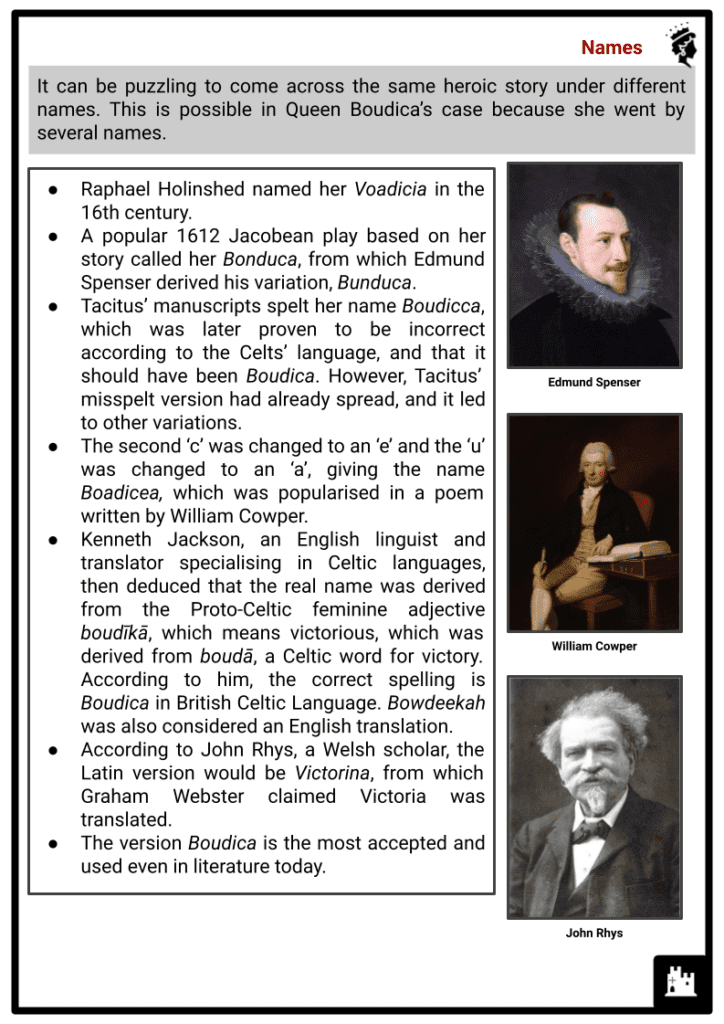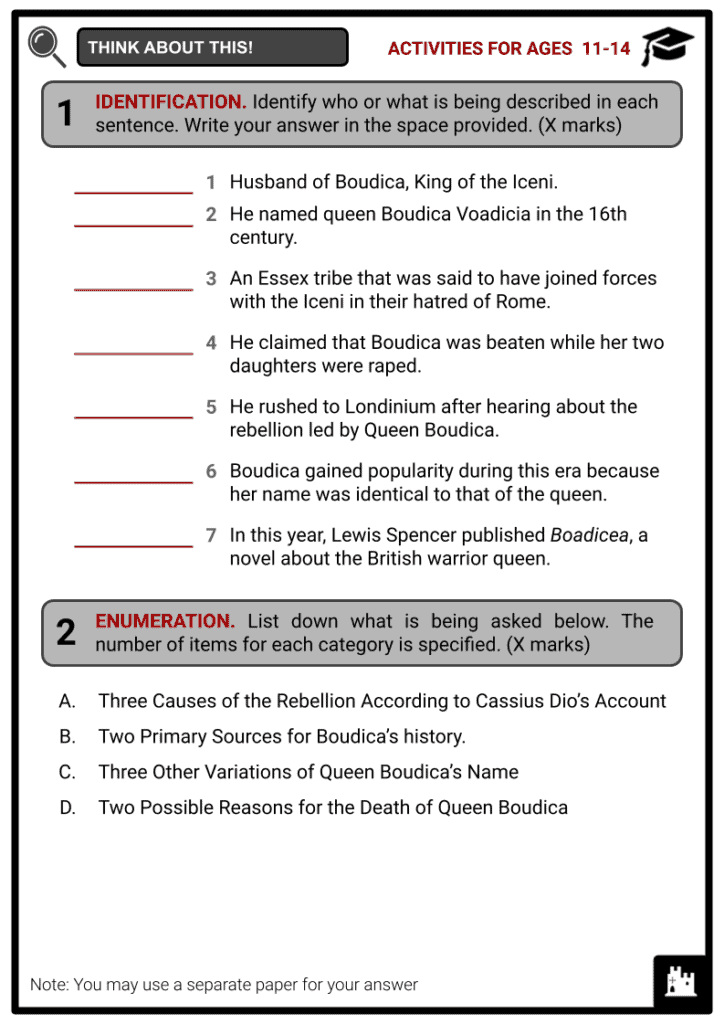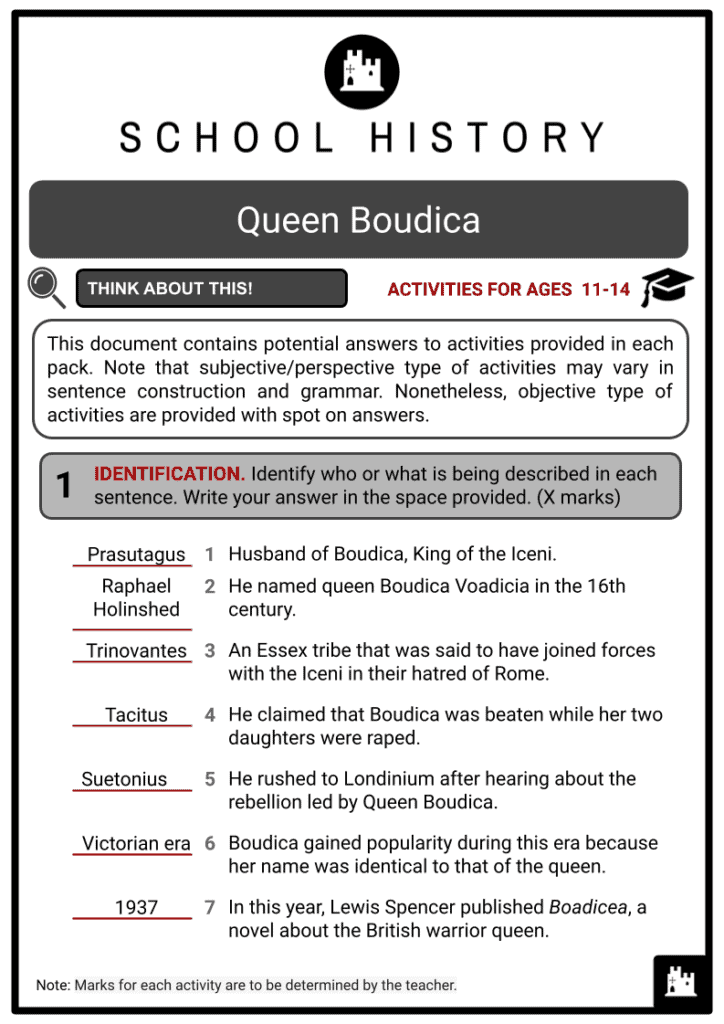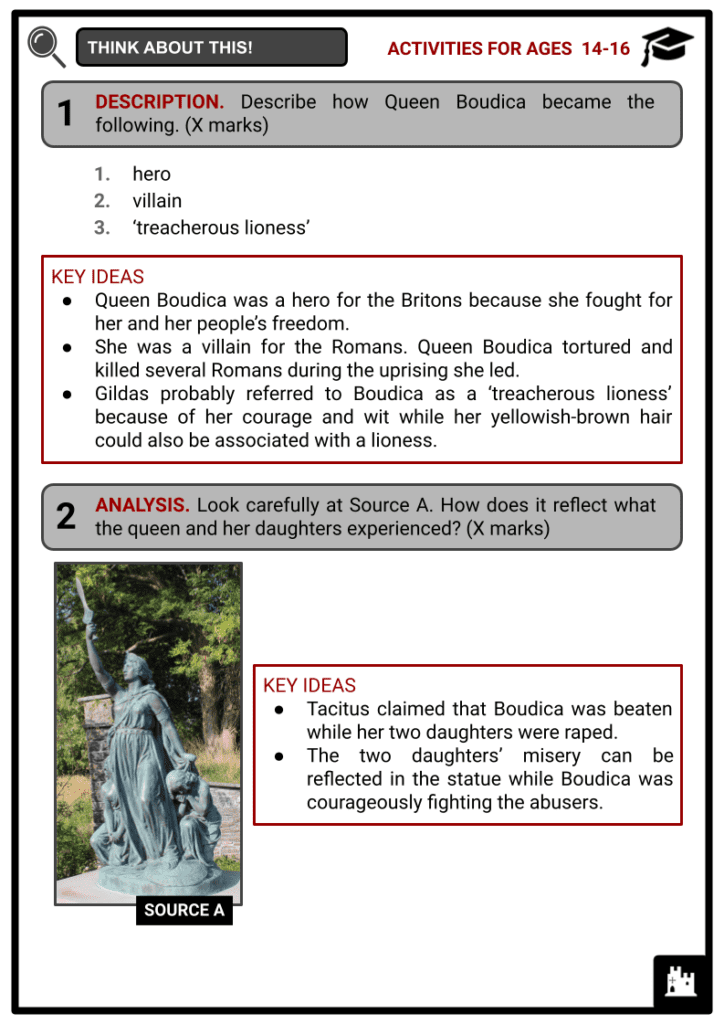Queen Boudica Worksheets
Do you want to save dozens of hours in time? Get your evenings and weekends back? Be able to teach about Queen Boudica to your students?
Our worksheet bundle includes a fact file and printable worksheets and student activities. Perfect for both the classroom and homeschooling!
Summary
- Names
- Historical Background
- The Uprising
- Legacy
Key Facts And Information
Let’s find out more about Queen Boudica!
Boudica was a British queen from the Iceni tribe who became famous for leading an uprising against Roman conquerors in CE 60 or 61 and is now regarded as a British folk hero. According to Roman sources, she died of self-poisoning or wounds received shortly after successfully blocking the uprising. Boudica’s followers tortured and killed approximately 70,000 Romans and Britons. Suetonius, the Roman governor, defeated the Britons after regrouping his forces in the West Midlands. This is when, according to the Romans, Boudica committed suicide to avoid capture by the Romans.

Names
- It can be puzzling to come across the same heroic story under different names. This is possible in Queen Boudica’s case because she went by several names.
- Raphael Holinshed named her Voadicia in the 16th century.
- A popular 1612 Jacobean play based on her story called her Bonduca, from which Edmund Spenser derived his variation, Bunduca.
- Tacitus’ manuscripts spelt her name Boudicca, which was later proven to be incorrect according to the Celts’ language, and that it should have been Boudica. However, Tacitus’ misspelt version had already spread, and it led to other variations.
- The second ‘c’ was changed to an ‘e’ and the ‘u’ was changed to an ‘a’, giving the name Boadicea, which was popularised in a poem written by William Cowper.
- Kenneth Jackson, an English linguist and translator specialising in Celtic languages, then deduced that the real name was derived from the Proto-Celtic feminine adjective boudīkā, which means victorious, which was derived from boudā, a Celtic word for victory. According to him, the correct spelling is Boudica in British Celtic Language. Bowdeekah was also considered an English translation.
- According to John Rhys, a Welsh scholar, the Latin version would be Victorina, from which Graham Webster claimed Victoria was translated.
- The version Boudica is the most accepted and used even in literature today.
Historical Background
- Boudica’s presence was described as terrifying by Cassius, a Roman historian, because of her height and yellowish-brown-colored long hair, as well as her harsh voice and sharp glare.
- Boudica was the wife of Prasutagus, King of the Iceni.
- The Roman conquest of southern Britain, led by Emperor Claudius, began in 43 CE. The Romans received the king’s support.
- The Iceni, independent of the king, revolted in 47 CE after the Roman governor Publius Ostorius Scapula attempted to spark local uprisings.

1855 Bronze Statue of Boudica and her Two Daughters - The Iceni, on the other hand, remained independent under Prasutagus, despite their initial success.
- The king was said to be pro-Roman, so that when he died around 60 CE, half of his fortune was left to his two daughters, with the remainder going to the Roman Emperor.
- Trinovantes, an Essex tribe, was said to have joined forces with the Iceni in their hatred of Rome. The main reason for the rebellion was Roman mistreatment.
- Tacitus claimed that Boudica was beaten while her two daughters were raped. Boudica reflected on how much better their lives had been before the Roman occupation. The Iceni could no longer enjoy their wealth due to Roman slavery. Boudica even blamed herself for not expelling the Romans as quickly as they did Julius Caesar.
- Tacitus and Cassius Dio were the primary sources for Boudica’s history. Gnaeus Julius Agricola, Tacitus’ father-in-law, was a military tribune under Suetonius Paulinus. In Suetonius’ absence, the Britons, according to him, began to congregate under Boudica.
- According to Cassius Dio’s account, the three causes of the rebellion were:
- recalling loans made to Britons
- confiscation of money previously loaned to the Britons by Emperor Claudius
- Boudica’s contributions
The Uprising
- Around the year 60, Roman governor Gaius Suetonius Paulinus led a campaign against the Welsh island of Mona. When he heard of Boudica’s rise, he marched quickly to the east, leaving the current conquest unfinished. The Iceni and Trinovantes, led by Boudica, had 120,000 men.
- Boudica’s army first targeted the Roman colony of Camulodunum, which they successfully captured. They took the head of Emperor Nero’s bronze statue as a trophy.
- Commander Quintus Petillius Cerialis attempted to relieve the city but was defeated after his infantry was slaughtered, leaving only him and some of his cavalry.
- Catus Decianus eventually fled to Gaul.
- After hearing about the rebellion, Suetonius rushed to Londinium. He considered fighting a battle there despite not having enough troops.
- Catus Decianus defected to Gaul, driving away the wealthy citizens and traders.
- The rebels were left in charge of Londonium. The rebels, on the other hand, burned it down after torturing and killing the survivors who were unable to flee.
- Tacitus claimed that the Britons were uninterested in making a profit and were only interested in killing by gibbet, fire or cross.
- While Suetonius reorganised his forces, Boudica’s army continued the uprising. Suetonius’ men were outnumbered, but Boudica’s army was defeated, according to Dio.
- Their fight was said to have taken place somewhere on Watling Street. But according to Kevin K Carroll, the battle that defeated Boudica took place near High Cross, Leicestershire which implies that Legio II Augusta assisted Suetonius in inferring the queen’s defeat.
- Tacitus claimed in his Annals that Boudica poisoned herself, despite the fact that an earlier manuscript titled ‘Agricola’ made no mention of suicide. Dio, on the other hand, claimed that Boudica died of illness and was extravagantly buried.
- There is no information in historical records about what happened to Boudica’s two daughters.
Legacy
- Aside from Tacitus and Dio’s accounts, the British monk Gildas mentioned Boudica in his 6th-century literary work On the Ruin and Conquest of Britain. Boudica was most likely referred to as the ‘treacherous lioness’ who defeated the Roman governors by Gildas.

Boadicea and Her Daughters by Thomas Thornycroft - The rediscovery of Tacitus’ works during Elizabeth I’s reign established Boudica as a significant figure in British history. According to legend, Elizabeth defended Britain against a possible Spanish invasion in 1588, influenced by Boudica’s story.
- In 1610, Francis Beaumont and John Fletcher wrote Bonduca, a play, and in 1782, William Cowper wrote Boadicea, an Ode.
- Boudica gained popularity during the Victorian era because her name was identical to that of the queen. Many poems have been written about her, and ships have been named after her.
- Thomas Thornycroft created the statue ‘Boadicea and Her Daughters’ in the 1860s, specifically using Prince Albert’s horses as models.
- Sir John, his son, cast the statue in bronze and presented it to the London County Council in 1902.
- Lewis Spencer published Boadicea, a novel about the British warrior queen, in 1937. However, historians claim that Spencer went so far as to include a map of the armies’ positions.
Image Sources
- https://upload.wikimedia.org/wikipedia/commons/b/bd/Queen_Boudica_by_John_Opie.jpg
- https://upload.wikimedia.org/wikipedia/commons/thumb/b/bc/Boadicea%2C_Brecon%2C_by_John_Thomas.jpg/330px-Boadicea%2C_Brecon%2C_by_John_Thomas.jpg
- https://upload.wikimedia.org/wikipedia/commons/thumb/9/94/Boudica_%28Aldaron%29.jpg/330px-Boudica_%28Aldaron%29.jpg






